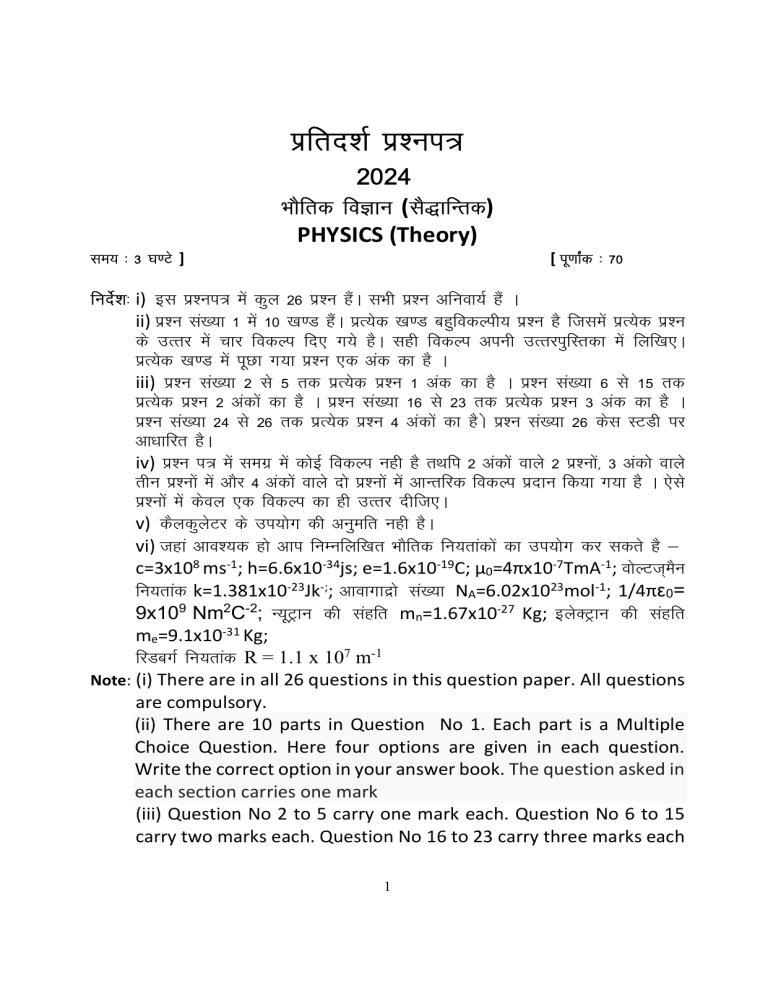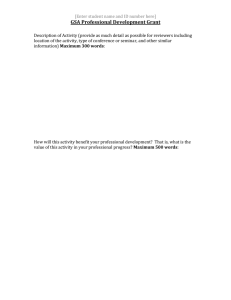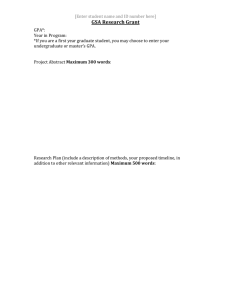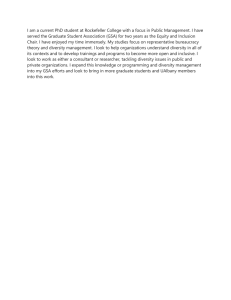
Ikzfrn”kZ iz”ui=
2024
Lke; % 3 ?k.Vs ]
HkkSfrd foKku (lS)kfUrd)
PHYSICS (Theory)
[ iw.kkZad % 70
funsZ”k% i) bl iz”ui= esa dqy 26 iz”u gSaA lHkh iz”u vfuok;Z gSa A
ii) iz”u la[;k 1 esa 10 [k.M gSaA izR;sd [k.M cgqfodYih; iz”u gS ftlesa izR;sd iz”u
ds mRrj esa pkj fodYi fn, x;s gSA lgh fodYi viuh mRRkjiqfLrdk esa fyf[k,A
izR;sd [k.M esa iwNk x;k iz”u ,d vad dk gS A
iii) iz”u la[;k 2 ls 5 rd izR;sd iz”u 1 vad dk gS A iz”u la[;k 6 ls 15 rd
izR;sd iz”u 2 vadkas dk gS A iz”u la[;k 16 ls 23 rd izR;sd iz”u 3 vad dk gS A
iz”u la[;k 24 ls 26 rd izR;sd iz”u 4 vadksa dk gSAs iz”u la[;k 26 dsl LVMh ij
vk/kkfjr gSA
iv) iz”u i= esa lexz esa dksbZ fodYi ugh gS rFkfi 2 vadksa okys 2 iz”uksa] 3 vadks okys
rhu iz”uksa esa vkSj 4 vadkas okys nks iz”uksa esa vkUrfjd fodYi iznku fd;k x;k gS A ,sls
iz”uksa esa dsoy ,d fodYi dk gh mRrj nhft,A
v) dSydqysVj ds mi;ksx dh vuqefr ugh gSA
vi) tgka vko”;d gks vki fuEufyf[kr HkkSfrd fu;rkadksa dk mi;ksx dj ldrs gS &
c=3x108 ms-1; h=6.6x10-34js; e=1.6x10-19C; µ0=4πx10-7TmA-1; oksYVt~eSu
fu;rkad k=1.381x10-23Jk-;; vkokxknzks la[;k NA=6.02x1023mol-1; 1/4πε0=
9x109 Nm2C-2; U;wVªku dh lagfr mn=1.67x10-27 Kg; bysDVªku dh lagfr
me=9.1x10-31 Kg;
fjMcxZ fu;rkad R = 1.1 x 107 m-1
Note: (i) There are in all 26 questions in this question paper. All questions
are compulsory.
(ii) There are 10 parts in Question No 1. Each part is a Multiple
Choice Question. Here four options are given in each question.
Write the correct option in your answer book. The question asked in
each section carries one mark
(iii) Question No 2 to 5 carry one mark each. Question No 6 to 15
carry two marks each. Question No 16 to 23 carry three marks each
1
and Question No 26 to 28 carry four marks each. Question No 28 is
based on Case study.
(iv) There is no overall choice in Question paper, however an
internal choice has been provided in two questions of 2 marks, three
questions of 3 marks and all questions of 4 marks each. You have to
attempt only one of the given choices in such questions.
(v) Use of calculator is not permitted.
(vi)You may use following values of physical constants wherever
necessaryc=3x108 ms-1; h=6.6x10-34js; e=1.6x10-19C; µ0=4πx10-7TmA-1;
Boltzman Constant k=1.381x10-23Jk-1, Avagadro Number
NA=6.02x1023 mol-1; 1/4πε0= 9x109 Nm2C-2; Mass of neutron
mn=1.67x10-27 Kg; Mass of electron me=9.1x10-31 Kg; Rydberg
Constant R = 1.1 x 107 m-1
1. (i) ,d lsy dk fo|qrokgd cy E oksYV gS] tc bls y?kqifFkr djrs gSa rks bldk
VfeZuy oksYVst gksxk&
1
EMF of a Cell is E Volts. When it is short circuited, its terminal voltage
will be¼a½ E Volt
¼b½ E/2 Volt
¼c½ Zero
¼d½ E/3 Volt
(ii) fuEu esa ls dkSu lh fo|qr pqEcdh; rjax ugh gS&
Which of the following is not an electromagnetic wave(a) X-fdj.ksa
X-rays
(b) γ-fdj.ksa
γ-rays
(c) β-fdj.ksa
β- rays
2
1
(d) vojDr fdj.ksa
Infrared rays
(iii) izdk’k oS|qr izHkko ls lEcfU/kr iz;ksx esa vkifrr izdk’k dh vko`fRRk dks nksxquk djus ij fujks/kh
foHko gks tk;sxk&
1
In Experiment related to Photo electric effect on doubling the frequency
of incident light the retarding potential becomes¼a½ nksxquk
Double
¼b½ vk/kk
Half
¼c½ nksxqus ls vf/kda
More than double
¼d½ nksxqus ls de
Less than double
(iv) rhu inkFkksZa ds ÅtkZ cS.M fuEu fp= esa fn, x;s gSa&
Energy bands of three substances are shown in following figure-
Eg>3ev
Eg<3ec
Eg=0
;s inkFkZ gS dze”k%&
These substances are respectively¼aa½ pkyd] v)Zpkyd] dqpkyd
Conductor, Semiconductor, Insulator
¼b½ v)Zpkyd] dqpkyd] pkyd
Semiconductor, Insulator, Conductor
¼c½ dqpkyd] pkyd] v)Zpkyd
Insulator, Conductor, Semiconductor
3
¼d½ dqpkyd]v)Zpkyd] pkyd
Semiconductor, Conductor, Insulator
(v) gkbMªkstu ijek.kq ds ewy ÅtkZ Lrj esa bysDVªku dk dks.kh; laosx gS&
1
Angular momentum of Hydrogen atom in its ground state is(a) h/π
(b) h/2 π
(c) h/4π
(d) 2h/ π
(vi) ok;q ds lkis{k dkap vkSj ty ds viorZukd Øe'k% 3@2 vkSj 4@3 gSaA dkp dk ty
ds lkis{k viorZukd gS&a
1
The refractive indices (R.I.) of glass and water with respect to air are 3/2
and 4/3 respectively. The R.I. of glass w.r. to water is(a) 8/9
(b) 9/8
(c) 7/6
(d) 2
(vii) ;fn vkosf”kr d.k dk osx nqxuk rFkk pqEcdh; {ks= dk eku vk/kk tk;s rks vkosf”kr
d.k ds ekxZ dh f=T;k gks tk;sxh&
If velocity of charged particleis doubled and value of magnetic field is
halved then radius of the path of charged paricle will become(a) 8 xquk
8 times
(b) nks xquk
Double
(c) pkj xquk
4 times
(d) 3 xquk
3 times
(viii) fo|qrjks/kh rkj dh ,d dq.Myh ,d cSVjh ls la;ksftr gSA ;fn bls xSYouksehVj ds
ikl ys tk;k tk, rks] bldk lwpd fo{ksfir gks tkrk gS] D;ksafd&
1
A coil of insulated wire is connected to a battery. If it is taken to
galvanometer, its pointer is deflected, because(a) izsfjr /kkjk mRiUu gksrh gSA
4
the induced current is produced
(b) dq.Myh ,d pqEcd dh Hkkafr dk;Z djrh gS
the coil acts like a magnet
¼c½ dq.Myh esa Qsjksa dh la[;k cny tkrh gS
the number of turns in the coil of the galvanometer are changed
a(d) mijksDr esa ls dksbZ ugha
None of the above
uksV&fuEu iz”uksa esa nks dFkuksa dks vfHkdFku ¼A½ vkSj dkj.k ¼R½ ds :Ik es fpfUgr fd;k
x;k gSA vius mRrj uhps fn, x;s dksM ds vuqlkj vafdr djsa&
Note-In following questions two statements are labeled as Assertion and
Reason. While answering these questions, you are required to choose any
one of the following four responses.
¼a½ A rFkk R nkuksa lR; gS rFkk R, A dh lgh O;k[;k djrk gSA
Both Assertion and Reason are correct and the Reason is a correct
explanation of the Assertion.
¼b½ A rFkk R nkuksa lR; gS ysfdu R, A dh lgh O;k[;k ugh djrk gSA
Both A and R are correct but Reason is not a correct explanation of the
Assertion.
¼c½ A lR; gS ysfdu R vlR; gSA
A is correct, R is incorrect
¼d½ A rFkk R nksuka vlR; gSA
Both A and R are incorrect
¼ix½ vfHkdFku¼A½& oS|qr {ks= dh fn”kk lnSo lefoHko i`’B ds yEcor gksrh gSA
The direction of the electric field is always perpendicular to the
equipotential surface
dkj.k¼R½& lefoHko i`’B ij fdlh fcUnq vkos”k dks ,d LFkku ls nwljs LFkku rd ys tkus
esa fd;k x;k dk;Z “kwU; gksrk gSA
Work done in moving a point charge from one place to other on
equipotential surface is zero.
¼x½ vfHkdFku¼A½& tc “osr izdk”k dkap ds fizTe ls gksdj xqtjrk gS rks vius vo;oh jaxksa
esa foHkkftr gks tkrk gSA
When white light passes through a glass prism it disperses into its
constituent colours.
dkj.k¼R½& izdk”k dh vko`fRr ,d ek/;e ls nwljs ek/;e esa tkus esa ifjofrZr gksrh gSA
5
When light enters from medium to other its frequency is changed.
2. vkosf”kr [kks[kys xksyh; dks”k ds dsUnz ij oS|qr {ks= dh rhozrk ,oa foHko fdruk gksrk
gS\
1
What is the intensity and potential of the electric field at the center of a
charged hollow spherical shell?
3. ,d izR;korhZ /kkjk ifjiFk dk “kfDr xq.kakd 0-5 gSA ifjiFk esa /kkjk rFkk oksYVst ds e/;
dykUrj D;k gksxk\
1
Power factor of an a.c. circuit is 0.5. What will be the phase difference
between voltage and current in the circuit?
4. ,d mÙky ysal dks ,d rjy inkFkZ esa Mqcks;k tkrk gS ftldk viorZukad ysal ds
viorZukad ds cjkcj gksrk gSA rks fQj bldh Qksdl nwjh D;k gS \
1
A convex lens is dipped in a liquid whose refractive index is equal to the
refractive index of the lens. Then what is its focal length?
5. fdlh v)Z rjax fn’Vdj.k esa] fuxZe vko`fr D;k gksxh ;fn fuos”kh vko`fRr 50 gVZt gSA
1
In half wave rectification, what is the output frequency if the input
frequency is 50 Hz.
6. l Hkqtk okys ?ku ds dsaæ ij ,d vkos'k q j[kk x;k gSA ?ku ds çR;sd i`"B ls xqtjus okyk
fo|qr Q~yDl D;k gS\
2
A charge ‘q’ is placed at the centre of a cube of side l. What is the
electric flux passing through each face of the cube?
7. ,d çksV‚u vkSj ,d bysDVª‚u dh xfrt ÅtkZ leku gSA fdldh Mh&cz‚xyh rjaxnS?kZ~;
NksVh gS vkSj D;ksa\s
2
A proton and an electron have same kinetic energy. Which one has
smaller de-Broglie wavelength and why?
8. dq.Mfy;ksa ds ;qXe ds vU;ksU; izsjdRo ij D;k izHkko iM+rk gS] tc
(a) dq.Mfy;ksa ds chp dh nwjh c<+k nh tkrh gSA
(b)tc nksuksa dq.Mfy;ksa esa Qsjksa dh la[;k c<+k nh tkrh gSA
2
How is the mutual inductance of a pair of coils affected when
(a) Separation between the coils is increased.
(b)The number of turns of each coil is increased.
9. ,d lekUrj IysV la/kkfj= dh IysVksa ds chp dh nwjh d gSA IysVksa ds chp d/2 eksVkbZ
dh ,d /kkrq dh IysV j[kh tkrh gSA /kkfjrk ij D;k çHkko iM+sxk\
2
6
The distance between the plates of a parallel plate capacitor is d. A
metal plate of thickness d/2 is placed between the plates. What will be
the effect on the capacitance?
10. 600 dks.k okyk fizTe 300 dk fopyu nsrk gSA fizTe ds inkFkZ dk viorZukad D;k
gksxk\
2
Prism of angle 600 gives a deviation of 300 . What is the refractive index
of material of the prism?
vFkok
pkj ySUlksa dh Qksdl nwjh o }kjd dk O;kl fuEukuqlkj gS&
Focal lengths and diameters of aperature of four lenses are as following-
A
B
C
D
Lens Focal Length ¼ySUl dh Qksdl nwjh½
Lens Aperture ¼ySUl }kjd dk O;kl½
100cm
100cm
10cm
5cm
10cm
5cm
2cm
2cm
fn, x;s pkj ySUlksa esa ls fdu nks ySUlksa dks vfHkn`”;d ,oa usf=dk ds :Ik esa p;fur dj
[kxksyh; nwjn”khZ cuk;k tk ldrk gS\ dkj.k Hkh crkb;sA
Which of the given four lenses should be selected as objective and
eyepiece to construct an astronomical telescope? Give reasons also.
11. cksj ds ijek.kq ekMy dh lhek,a crkb;sA
2
State the limitations of Bohr’s atomic model.
vFkok
cksj f=T;k vFkZ gS\ bldk eku fyf[k,A
What is Bohr’s radius? Write its value.
12. ;|fi VªkalQkeZj dh nks dq.Mfy;ksa ds chp dksbZ lh/kk fo|qr la;kstu ugha gksrk gS] fQj
Hkh ÅtkZ çkFkfed dq.Myh ls f}rh;d dq.Myh esa LFkkukarfjr gks tkrh gSA dSl\s
2
Although there is no direct electrical connection between the two coils
of a transformer, yet energy is being transferred from primary coil to
secondary coil. How?
13. ,d uSt v)Zpkyd dks N rFkk P izdkj ds v)Zpkyd esa dSls ifjofrZr fd;k tkrk
gS\ la{ksi esa crk,aA
2
7
How an intrinsic semiconductor is converted into N type and P type
semiconductor? State briefly.
14. fuEu ifjiFk esa P o R ds e/; yxs feyhehVj esa oS|qr /kkjk dk eku Kkr dhft,A
2
In the following circuit diagram find the value of current in millimeter
connected between points P and R.
15. nks dyklEc) lzksrksa dh rhozrk dk vuqikr 81%1 gSA muds v?;kjksi.k ls cuus okys
O;kfrdj.k izfr:Ik ds mfPp’B rFkk fufEu’B dh rhozrkvksa dk vuqikr Kkr dhft,A
2
The intensity ratio of the two coherent sources is 81:1. Find the ratio of
intensities of maxima and minima of the interference pattern formed by
their superposition.
16. eqä vkdk'k esa 5x1019 Hz vko`fÙk dh fo|qr pqEcdh; rjaxksa dh rjax nSè;Z Kkr djsaA
fo|qr pqEcdh; rjax dks igpkusa vkSj blds nks vuqç;ksx crk,aA
3
19
Find the wavelength of electromagnetic waves of frequency 5x10 Hz in
free space. Identify the electromagnetic wave and state its two
applications.
17. fuEu vkjs[k esa iznf”kZr ,d Js.kh dze LCR ifjiFk¼L=5.0 H, C=80μF, R=40Ω½
230 oksYV ds izR;korhZ /kkjk L=ksr ds lkFk la;ksftr gSA
3
A Series LCR circuit (L=5.0 H, C=80μF, R=40Ω ) is connected to a 230
Volts alternating voltage source as shown in the following diagram.
8
(a) vuqukn ds fy, izR;korhZ /kkjk L=ksr dh vko`fRRk Kkr dhft,A
Find the frequency of the alternating current source for
resonance.
(b) vuquknh vko`fÙk ij ifjiFk dh çfrckèkk vkSj èkkjk dk vk;ke çkIr djsaA
Obtain the impedance of the circuit and the amplitude of current
at the resonating frequency.
18. gkbxsUl ds rjax fl)kUr dk mi;ksx djrs gq, izdk”k ds ijkorZu ds fu;eksa dk
lR;kiu djsaA
3
Using Huygen’s wave theory, verify the laws of reflection of light.
vFkok
(OR)
,dy js[kk fNnz ds dkj.k cuus okys foorZu izfr:Ik rFkk ;ax ds f}d js[kk fNnz iz;ksx ds
dkj.k cuus okys O;kfrdj.k izfr:Ik ds e/; izeq[k vUrj crkb;sA
State the main differences between the diffraction pattern formed due to
a single slit and the interference pattern formed due to Young's double
line aperture experiment.
19. izdk”k oS|qr izHkko D;k gS\ blls lEcfU/kr izdk”k oS|qr lehdk.k O;qRiUu dhft,A 3
What is photoelectric effect? Derive the photoelectric equation related to
it.
20.ok;q esa fLFkr ,d NksVs xksys ftl ij 𝟎. 𝟒𝛍𝑪 dk vkos”k gS ij nwljs NkVs xksys ftl
ij &0.8𝜇𝐶 dk vkos”k gS ds dkj.k 0.2𝑁 dk fLFkjoS|qr cy dk;Z dj jgk gSA
3
(a) nksuks xksykssa ds chp dh nwjh Kkr dhft,A
(a) nwljs xksys ij igys xksys ds dkj.k yxus okyk cy D;k gS\
The electrostatic force on a small sphere of charge 𝟎. 𝟒𝝁𝑪 due to
another small sphere of charge –𝟎. 𝟖𝝁𝑪 in air is 0.2N.
(a) Find the distance between the two spheres?
(b) What is the force on the second sphere due to the first?
21. fdlh pqEcdh; inkFkZ dh pqEcdh; izo`fRRk -2.6x10-5 gSA pqEcdh; inkFkZ ds izdkj dks
igpkfu, vkSj mlds pkj xq.k fyf[k,A
3
The susceptibility of a magnetic material is – 2.6 × 10-5. Identify the type
of magnetic material and state its four properties.
22. fuEu ukfHkdh; vfHkfdz;k esa voeqDr gksus okyh ÅtkZ dh x.kuk MeV esa dhft,% 3
9
Calculate the energy released in MeV in the following nuclear reaction:
vFkok
nks ukfHkdksa dh nzO;eku la[;kvksa dk vuqikr 1%8 gSA mudh ukfHkdh; f=T;kvksa dk vuqikr
D;k gksXkk\ muds ukfHkdh; ?kuRoksa dk vuqikr Hkh Kkr dhft,A
Two nuclei have mass numbers in the ratio 1: 8. What is the ratio of
their nuclear radii? Also find ratio of their nuclear densities.
23. p-n laf/k Mk;ksM ds fy, vo{k; ijr rFkk foHko izkphj dks ifjHkkf’kr dhft,A crkb;s
fd vo{k; ijr dh pkSM+kbZ fdl izdkj ifjofrZr gksxh tc p-n laf/k Mk;ksM &
(a) vxz vfHkur gksrk gSA (b)mRdze vfHkur gksrk gSA
3
Define the term depletion Layer and potential barrier for p-n junction
diode. State how the thickness of depletion layer will change when pn
junction diode is(a) forward biased
(b) reverse biased.
vFkok
(OR)
p-n laf/k fuekZ.k esa lfEefyr nks izfdz;kvksa dks le>kb;sA
3
Explain two processes involved in the formation of p-n junction diode.
24. fdlh pkyd dh izfrjks/kdrk dks ifjHkkf’kr dhft,A bldk ,l0 vkbZ0 ek=d crkb,A
fl) dhft, fd fdlh pkyd dk izfrjks/k R=
gksrk gS] tgka izrhdksa ds lekU; vFkZ
gSA
4
Define the term resistivity of a conductor. Give its SI unit. Prove that
resistance of a conductor R =
,where the symbols have their usual
meanings.
vFkok (OR)
¼a½fuEu ds fy, oS|qr cy js[kk,a [khfp,& (i) foyfxr /kukRed vkos”k
(ii) foyfxr _.kkRed vkos”k
10
Sketch electric lines of force for following (i) isolated positive change
(ii) isolated negative change
¼b½nks fcanq vkos'k q vkSj & q ,d nwljs ls 2aa dh nwjh ij j[ks x, gSaA vkos'kksa dks tksM+us
okyh js[kk ds yacor lef}Hkktd ds vuqfn'k nwjh r ij fLFkr fcanq P ij fo|qr {ks= dh
x.kuk djsaA tc r >> a gks rks oS|qr {ks= D;k gS\
Two point charges q and – q are placed at a distance of 2a from each
other. Calculate the electric field at a point P located at a distance r along
the perpendicular bisector of the line joining the charges. What is the
electric field when r >> a ?
25. ek/;ekas ds ,d ;qXe ds fy, dzkfUrd dks.k dks ifjHkkf"kr djsaA 15-0 lseh f=T;k okys ,d
flysaMj ds ryh ds dsaæ ij ,do.kÊ çdk'k dk ,d fcanq lzksr 'S' j[kk x;k gSA flysaMj esa 70 lseh dh ÅapkbZ rd ikuh ¼viorZukad 4@3½ gSA fdj.k vkjs[k cuk,a vkSj ikuh dh lrg
ds ml {ks= dh x.kuk djsa ftlls gksdj çdk'k ok;q esa fudyrk gSA
4
Define the term ‘critical angle’ for a pair of media.
A point source of monochromatic light ‘S’ is kept at the centre of the
bottom of a cylinder of radius 15.0 cm. The cylinder contains water
(refractive index 4/3) to a height of 7.0 cm. Draw the ray diagram and
calculate the area of water surface through which the light emerges in air.
vFkok (OR)
,d fcanq oLrq dks ,d f}mÙky ysal¼ok;q ds lkis{k viorZukad n ¾ n2@n1½ ftlds xksyh;
i`’Bksa dh oØrk f=T;k R1 vkSj R2 gS] ds lkeus j[kk x;k gS] ySUl ds xksyh; i`’Bksa dh oØrk
f=T;k R1 vkSj R2 gSaA oLrq dk okLrfod izfrfcEc çkIr djus ds fy, ysUl dh igyhs vkSj
nwljh lrg ij viorZu dk fdj.k vkjs[k [khafp,A
irys ysal ds fy, ysal&fuekZrk dk lw= çkIr djsaA
A point object is placed in front of a double convex lens (of refractive
index n = n2/n1 with respect to air) with its spherical faces of radii of
curvature R1 and R2. Show the path of rays due to refraction at first and
subsequently at the second surface to obtain the formation of the real
image of the object.
Obtain the Lens-maker’s formula for a thin lens.
26.
11
xSYosuksehVj ,d midj.k gS ftldk mi;ksx ifjiFk esa çokfgr èkkjk vFkok bleas yxk, x;s
y?kq foHkokUrj dk irk yxkus ds fy, fd;k tkrk gSA blesa dbZ Qsjkas okyh ,d dqaMyh gksrh
gS] tksfd ,d fLFkj v{k ds ifjr% ?kw.kZu ds fy, Lora= gksrh gS] ;g ,d pqEcd ds vory
i`’B okys /kzqoksa }kjk mRiUu +,dleku f=T; pqEcdh; {ks= esa fLFkr gksrh gSA tc blesa /kkjk
izokfgr gksrh gS rc bl ij ,d cy vk?kw.kZ dk;Z djrk gSA
The galvanometer is a device used to detect the current flowing in a circuit
or a small potential difference applied to it. It consists of a coil with many
turns, free to rotate about a fixed axis, in a uniform radial magnetic field
formed by using concave pole pieces of a magnet. When a current flows
through the coil, a torque acts on it.
(a)py dq.Myh /kkjkekih dk fl)kUr D;k gS\
1
What is the principle of moving coil galvanometer?
(b) ;fn pqEcdh; {ks= f=T; gS rks xSYosuksehVj dh dq.MYkh ds pqEcdh; vk?kw.kZ ,oa pqEcdh;
{ks= ds chp dk dks.k D;k gksxk\
1
If the magnetic field is radial, then what will be the angle between
magnetic moment of galvanometer coil and the magnetic field ?
(c) ;fn py dq.Myh /kkjkekih esa iz;qDr vk;rkdkj dq.Myh dks o`RRkkdkj cuk fn;k tk;s rks
dq.Myh ds leku {ks=Qy ds fy, pqEcdh; {ks= esa dq.Myh ij yxus okys vf/kdre cy
vk?kw.kZ ij D;k izHkko iM+sxk\ dkj.k Hkh nhft,A
2
If the rectangular coil used in the moving coil galvanometer is made
circular, then what will be the effect on the maximum torque acting on
the coil in magnetic field for the same area of the coil? Give reason also.
12



